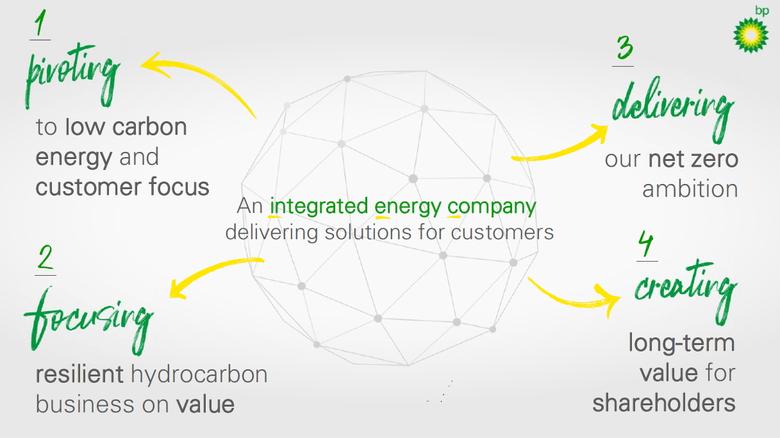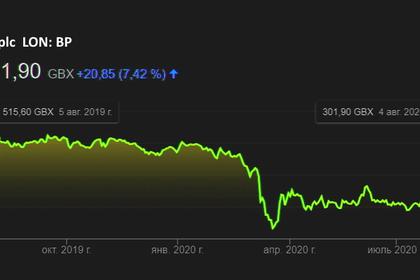
LOW CARBON BP STRATEGY

BP - 4 August 2020 - From International Oil Company to Integrated Energy Company: bp sets out strategy for decade of delivery towards net zero ambition
New strategy sees bp:
Pivoting to low carbon energy and customer focus
- 10-fold increase in low carbon investment by 2030, with up to 8-fold increase by 2025
- partnering with 10-15 cities and 3 core industries in decarbonization efforts and doubling customer interactions to 20 million per day, all by 2030
Focusing resilient hydrocarbon business on value:
- capital intensity decreasing as major project wave completes, combined with continued efficiency focus, to drive earnings and ROACE growth
- production declines by 40% by 2030 through active portfolio management
- no exploration in new countries
Delivering on net zero ambition
- emissions from bp’s operations 30-35% lower by 2030
- emissions associated with carbon in upstream oil and gas production 35-40% lower by 2030
- carbon intensity of products bp sells lower by more than 15% by 2030
Delivering long term value for shareholders
- reset resilient dividend of 5.25c/share per quarter, with commitment to return at least 60% of surplus cash as share buybacks
- profitable growth with 7-9% annual growth in EBIDA per share to 2025
- sustainable value with increasing investment in low carbon and non-oil and gas
Within 10 years, bp aims to have increased its annual low carbon investment 10-fold to around $5 billion a year, building out an integrated portfolio of low carbon technologies, including renewables, bioenergy and early positions in hydrogen and CCUS. By 2030, bp aims to have developed around 50GW of net renewable generating capacity – a 20-fold increase from 2019 – and to have doubled its consumer interactions to 20 million a day.
Over the same period, bp’s oil and gas production is expected to reduce by at least one million barrels of oil equivalent a day, or 40%, from 2019 levels. Its remaining hydrocarbon portfolio is expected to be more cost and carbon resilient.
By 2030, bp aims for emissions from its operations and those associated with the carbon in its upstream oil and gas production (addressed by Aim 1 and Aim 2 of bp’s net zero ambition) to be lower by 30-35% and 35-40% respectively.
bp also today sets out a new financial frame to support a fundamental shift in how it allocates capital, towards low carbon and other energy transition activities. The combination of strategy and financial frame is designed to provide a coherent and compelling investor proposition – introducing a balance between committed distributions, profitable growth and sustainable value – and create long-term value for bp’s stakeholders.
As part of the investor proposition, bp’s board has introduced a new distribution policy, with two elements:
- the dividend reset to a resilient level of 5.25 cents per share per quarter, and intended to remain fixed at this level, subject to the board’s decision each quarter, supplemented by
- a commitment to return at least 60% of surplus cash to shareholders through share buybacks, once bp’s balance sheet has been deleveraged and subject to maintaining a strong investment grade credit rating.
The strategy is built around three focus areas of activity and three distinctive sources of differentiation, underpinned by a new sustainability frame and advocacy for policies that support net zero.
The focus areas are:
- Low carbon electricity and energy: building scale in renewables and bioenergy, seeking early positions in hydrogen and CCUS, and building out a customer gas portfolio to complement these low carbon energies.
- Convenience and mobility: putting customers at the heart of what bp does, helping accelerate the global revolution in mobility, redefining the experience of convenience retail, and scaling bp’s presence and fuel sales in growth markets.
- Resilient and focused hydrocarbons: maintaining an absolute focus on safety and operational reliability, bp intends to drive capital and cost productivity up and emissions down. bp intends to complete the ongoing wave of major projects, decreasing capital intensity, and to continue to high-grade the portfolio, resulting in significantly lower and more competitive production and refining throughput. bp will not seek to explore in countries where it does not already have upstream activities. Rosneft is a fundamental part of bp’s broader portfolio and provides bp with a strong position in Russia.
The three sources of differentiation to amplify value are:
- Integrated energy systems: along and across value chains, pulling together all bp’s capabilities to optimise energy systems and create comprehensive offers for customers.
- Partnering with countries, cities, and industries: as they shape their own paths to net zero.
- Digital and innovation: to enable new ways to engage with customers, create efficiencies, and support new businesses.
Delivering the strategy will see bp become a very different company by 2030. By then, bp aims for:
- investment in low carbon energy to have increased from around $500 million to around $5 billion a year;
- developed renewable generating capacity to have grown from 2.5GW in 2019 to around 50GW;
- bioenergy production to have risen from 22,000 b/d to more than 100,000 b/d;
- hydrogen business to have grown to have 10% share of core markets;
- global customer interactions to have risen from 10 million to 20 million a day;
- electric vehicle charging points to have increased from 7,500 to over 70,000; and
- energy partnerships with 10-15 major cities around the world and three core industries.
Over the same time:
- Upstream oil and gas production is expected to reduce from 2.6 million barrels of oil equivalent a day (mmboe/d) in 2019 to around 1.5mmboe/d; and
- refining throughput is expected to fall from 1.7 million barrels a day (mmb/d) in 2019 to around 1.2mmb/d.
Through this change, bp will continue its commitment to performing as it transforms – maintaining its focus on safety, operational excellence and financial discipline.
Delivering bp’s net zero ambition
The introduction of the new strategy and transformation of bp are expected to deliver material progress towards its ambition to become net zero by 2050 or sooner and its supporting aims. By 2030, bp aims to have delivered significant progress against its first five Aims:
- Aim 1 – emissions from operations, 30-35% lower than in 2019;
- Aim 2 – emissions associated with the carbon in bp’s upstream oil and gas production, 35-40% lower than in 2019;
- Aim 3 – carbon intensity of marketed products, more than 15% lower than in 2019;
- Aim 4 – measurement of methane in place by 2023, and progress underway to halve its intensity;
- Aim 5 – investment in low carbon increased from $0.5 billion to around $5 billion a year – and to $3-4 billion by 2025.
New financial frame, investor proposition and distribution policy
bp also today introduces a new financial frame that will support this transformation and delivery of the strategy. It sets out bp’s clearly defined priorities for capital allocation:
- supporting a resilient dividend;
- deleveraging and maintaining a strong investment grade credit rating;
- investing at scale into the energy transition;
- investing in bp’s resilient hydrocarbons assets to maximise value and cash flow; and
- returning cash to shareholders through buybacks.
bp intends to maintain its financial discipline with a rigorous business plan, including strengthening its balance sheet, maintaining strict discipline on capital spending and deleveraging to reduce net debt to $35 billion.
bp intends to maintain annual capital expenditure -- including inorganic investment — in a range of $14-16 billion to 2025; keeping within the lower end of the $13-15 billion range until net debt has been reduced to $35bn. As it high-grades its portfolio, bp is also targeting $25 billion of divestment proceeds between the second half of 2020 and 2025.
Based on expected growth in profitability, and its focus on disciplined investment allocation, bp aims to deliver strong and growing returns, with ROACE rising to 12-14% in 2025(1). It also expects to rebalance its sources and uses of cash, on average over 2021-25, to a balance point of around $40/bbl Brent, assuming an average bp refining marker margin around $11/bbl and Henry Hub at $3/mmBtu in 2020 real terms.
bp is committed to delivering attractive returns to shareholders. Therefore, as part of the financial frame, bp’s board has put in place a new distribution policy, comprising two elements:
- a resilient dividend of 5.25 cents per share per quarter, with an intention that this level will remain fixed, subject to the board’s decision each quarter; and
- a commitment to return at least 60% of surplus cash flow to shareholders via share buybacks once net debt is reduced to $35 billion and subject to maintaining a strong investment grade credit rating(2).
The board believes setting a dividend at this level takes into account the current uncertainty regarding the economic consequences of the COVID pandemic, supports bp’s balance sheet and also provides the flexibility required to invest into the energy transition at scale. The commitment to return surplus cash as buybacks offers investors benefits from potential cash flow upside, while also reinforcing bp’s commitment to investment discipline.
The combination of this frame and the new strategy creates bp’s new investor proposition:
- Committed distributions: a resilient dividend, supplemented by a commitment to distribute surplus cash through share buybacks.
- Profitable growth: underlying business performance expected to drive growth in EBIDA per share at an average compounded annual growth rate of 7-9% to 2025(3), supported by the share buyback commitment.
- Sustainable value: with increasing investment in non-oil and gas, by 2025 more than 20% of bp’s capital is expected to be employed in transition businesses, including low carbon. This is expected to diversify and improve the resilience of bp’s cash flow.
-----
Earlier:









